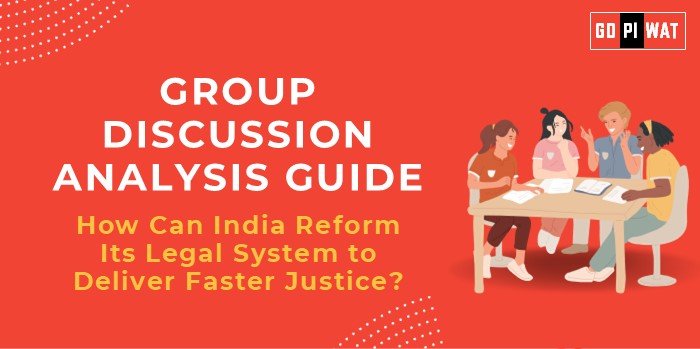📋 Group Discussion (GD) Analysis Guide: How Can India Reform Its Legal System to Deliver Faster Justice?
🌐 Introduction to the Topic
- 📜 Opening Context: “India’s legal system, with its roots in British-era practices, serves the largest democracy in the world but faces a backlog of over 40 million cases, highlighting the urgent need for reform to ensure faster justice.”
- 📖 Topic Background: India’s judiciary is celebrated for its independence but struggles with delays, resource constraints, and procedural inefficiencies. Despite efforts like e-courts and alternative dispute resolution (ADR), significant gaps remain.
📊 Quick Facts and Key Statistics
- 📈 Pending Cases: Over 40 million cases pending in Indian courts (2023) – Indicative of the workload on the judiciary.
- 👩⚖️ Judges per Million: 21 judges per million people (2022) – Among the lowest ratios globally, reflecting resource gaps.
- ⏳ Average Case Duration: 3–5 years for civil cases in district courts – Demonstrates systemic delays.
- 💻 E-Courts Initiative: Phase II completed in 2023; aims to digitize court records and processes – An important reform milestone.
👥 Stakeholders and Their Roles
- 🏛️ Government: Policy-making, funding, and legislative amendments.
- ⚖️ Judiciary: Interpretation of laws, speedy adjudication, and efficient case management.
- 🧑⚖️ Legal Professionals: Advocacy and promoting ADR mechanisms.
- 🌐 Civil Society: Monitoring legal reforms and supporting justice delivery at the grassroots.
🏆 Achievements and Challenges
✨ Achievements
- 💻 Digitization Efforts: Over 20,000 courts digitized under the e-Courts project, improving transparency.
- 🤝 ADR Growth: Widespread adoption of Lok Adalats, resolving 10 million+ cases annually.
- ⚖️ Landmark Judgments: High-impact rulings on issues like environmental protection and human rights.
⚠️ Challenges
- 📉 Case Backlog: Overwhelming volume of pending cases in district and high courts.
- 👩⚖️ Understaffing: Critical shortage of judges and judicial staff.
- 📚 Legal Awareness: Limited legal literacy among citizens, especially in rural areas.
Global Comparisons:
• United States: Effective use of ADR and plea bargaining.
• Singapore: AI-driven case management reduces case resolution times significantly.
Case Study: Delhi Fast Track Courts – Post-2012, reduced trial durations in cases of sexual violence, showcasing targeted reforms.
📢 Structured Arguments for Discussion
- 💬 Supporting Stance: “India’s adoption of e-Courts and Lok Adalats highlights significant strides towards faster justice delivery.”
- 🗣️ Opposing Stance: “Reforms remain superficial without addressing the root causes like understaffing and procedural complexities.”
- ⚖️ Balanced Perspective: “While legal digitization is promising, systemic and structural reforms are essential for long-term efficiency.”
📈 Effective Discussion Approaches
- 💡 Opening Approaches:
- Quote: “Justice delayed is justice denied – a reality for millions in India’s judicial system.”
- Comparative Data: “India has 21 judges per million people compared to the US’s 107.”
- 💡 Counter-Argument Handling:
- Acknowledge constraints (e.g., resource gaps) but emphasize scalable reforms like ADR and AI-based tools.
📊 Strategic Analysis of Strengths and Weaknesses
Strengths
- ⚖️ Constitutional independence.
- 💻 Proactive judiciary and digital reforms.
Weaknesses
- 📉 Overburdened courts.
- 📜 Procedural inefficiencies.
Opportunities
- 🤖 Technology-driven solutions.
- 🤝 ADR mechanisms.
Threats
- ⚠️ Public distrust.
- 📈 Increasing litigation rates.
🎓 Connecting with B-School Applications
- 💡 Real-World Applications:
- Case studies in operational efficiency and process innovation for B-school research.
- 💡 Sample Interview Questions:
- “How can technology improve legal system efficiency?”
- “What role does legal awareness play in faster justice?”
- 💡 Insights for B-School Students:
- Effective resource management, application of AI in service delivery, and policy impact assessment.


